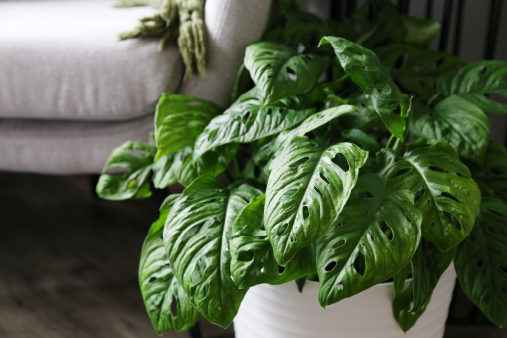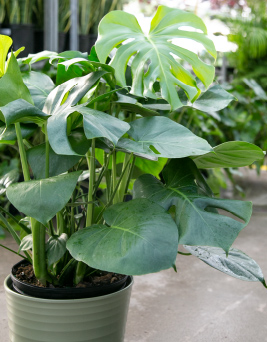HOUSEPLANTS
MONSTERA
Belonging to the genus Monstera, these vining plants are native to the tropical regions of Central America. They have quickly risen to popularity in the houseplant world due to their ease of care and their incredible leaves.
Note: Most of this information applies to more common varieties of Monstera such as Monstera deliciosa and Monstera adansonii. Uncommon varieties such as Monstera dubia are a little fussier about humidity and potting mix. Always make sure to look up your specific variety to ensure you are providing the best care possible!
Light
Like most tropical plants, Monstera prefer bright, indirect light. For indirect light, your plant should be able to see as much of the sky as possible, without seeing the sun. This is typically a space within 2-5 feet of a large window. If Monstera are exposed to too much direct sunlight their leaves will burn, but without enough light, you risk losing fenestrations (splitting) on your new leaves.
Water
To keep things basic, you should water your Monstera when the top ¼ - ½ of your pot is dry (you can check by sticking your finger deep into the soil). They should not dry out entirely, but if your plant is still moist on top, skip that watering! Keep in mind, the frequency of watering may vary throughout the year as the seasons, temperature, and the amount of light your plant is receiving changes.

Temperature & Humidity
Monstera prefer to be kept in temperatures in the 20-25°C range and they really dislike cold drafts so be aware of any nearby vents, open windows, or doors. Monstera benefit from having higher humidity but they will tolerate dry air much better than other tropical plants.
Fertilizer
Fertilize throughout the growing season (generally May to September) with a regular houseplant fertilizer and follow the directions on the package to feed the correct amount. You should not fertilize during the fall and winter months as plants are not actively growing and need a dormancy or rest period. If you are seeing lots of active growth and newly emerging leaves in the dormancy period, you could do one application of fertilizer to support the new growth.
Growing Mediums & Repotting

When it comes to soil, Monstera aren’t too picky compared to some other species. Use either a regular potting mix or one specifically formulated for tropicals. If you’d like, you can incorporate additional perlite and/or orchid bark to reduce soil compaction and increase aeration, but remember this means you will likely need to increase your watering frequency as the soil will dry out faster. Monstera prefer to be a little bit root-bound, so don’t be too quick to repot them; the roots should be starting to form a mat on the edge of the pot first. When you decide it’s time, remember that your new pot should only be 1-2” larger than your previous pot and it is best to repot during the active growing season (spring or summer)!
The majority of Monstera are actually vines and grow best when they have some sort of support, such as a moss pole, to climb up. In their native habitats, they attach themselves to tree trunks, rock walls, and even sides of buildings. Without something to climb, they will start to grow outwards and can get large and out of hand quickly! When choosing your plant support, make sure you pick something with a little extra height so your plant can grow into it, and bury it deep in the soil so it is stable enough to support the weight.
For more information on light, watering, and some basic terms, check out Houseplants 101!




